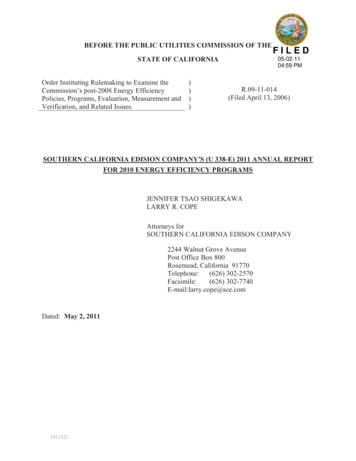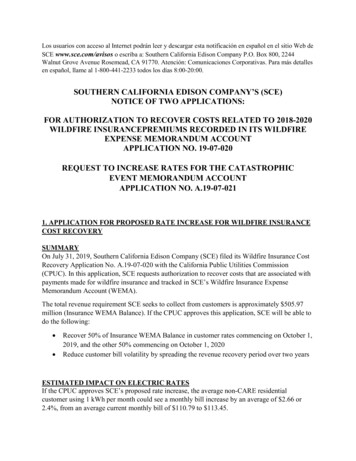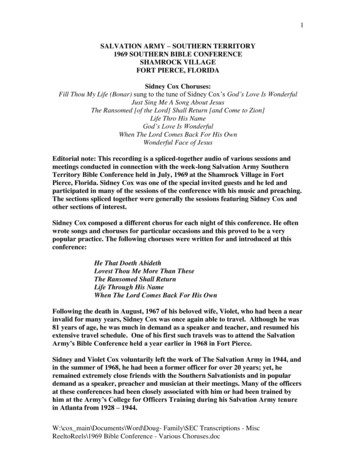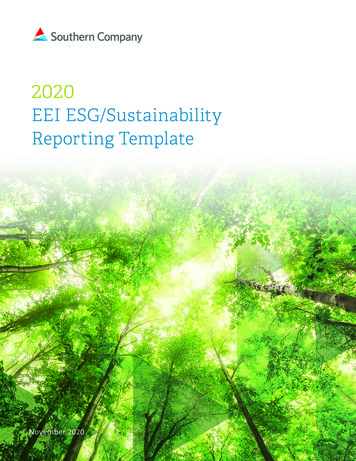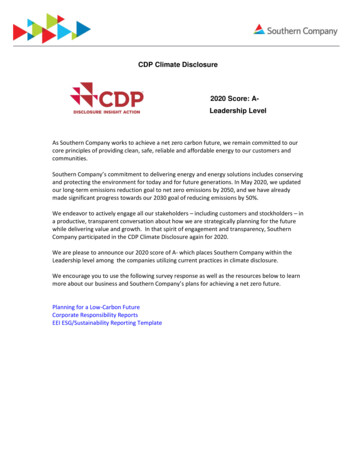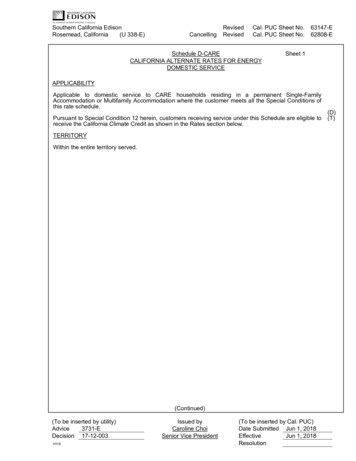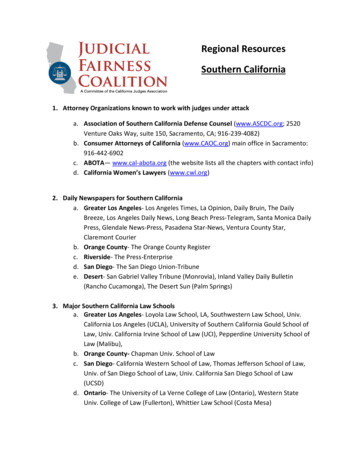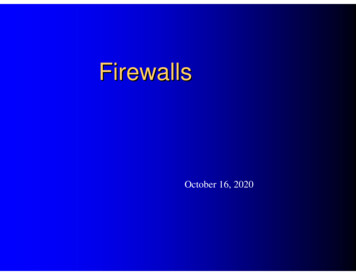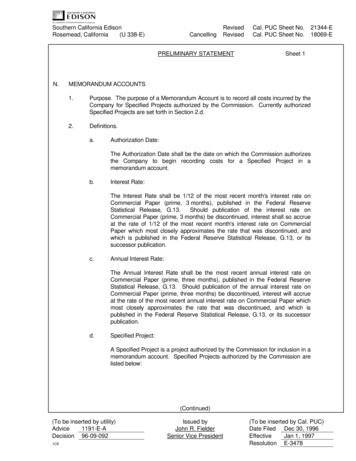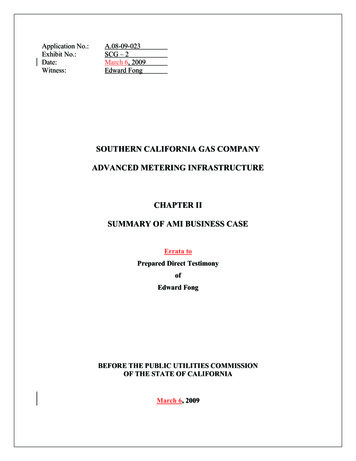
Transcription
Application No.:Exhibit No.:Date:Witness:A.08-09-023SCG – 2March 6, 2009Edward FongSOUTHERN CALIFORNIA GAS COMPANYADVANCED METERING INFRASTRUCTURECHAPTER IISUMMARY OF AMI BUSINESS CASEErrata toPrepared Direct TestimonyofEdward FongBEFORE THE PUBLIC UTILITIES COMMISSIONOF THE STATE OF CALIFORNIAMarch 6, 2009
I.TABLE OF CONTENTSINTRODUCTION. 1II.SUMMARY OF RESULTS . 1III.BACKGROUND AND FOUNDATION FOR THE AMI BUSINESS CASE . 5A. PG&E and SDG&E AMI Deployments Include AMI Gas Modules and Daily Gas Meter Reads . 5B. SDG&E’s Experience with AMI Implementation Provides SoCalGas with a ReasonableBenchmark for Vendor Cost Estimates of the Hybrid and Stand Alone Scenarios. 5C. Integration with SCE’s AMI System Will Require Enhancements to Separately Collect and Trackthe SoCalGas Meter Read at the Electric Meter Level and Head-End System and RequireAdditional Hardware . 6IV.BUSINESS CASE ANALYSIS . 6A. Implementation of a Stand Alone AMI System is the Best Alternative for SoCalGas Customers . 6B. Deployment of the Hybrid Only AMI System with SCE/SoCalGas Overlap Customers is Not aViable Solution. 7C. SoCalGas Operational Efficiencies are Reflected in Estimated Benefits and will Net Against GasAMI Deployment Revenue Requirements During the Deployment Period . 8D. Gas Conservation Impact and Benefits . 8E. The Hybrid Scenario Cost Estimates Include SCE AMI Services Fees and Charges that areAssumed to be Incremental Cost Based . 9F. SoCalGas’ AMI Project Provides Net Societal Benefits of 27.321.5 Million and Net RatepayerPVRR Benefits of 19.013.2 Million Given an Approximate 1% Conservation Impact. . 10G. Revenue Requirements and Ratepayer Benefits. 11V.KEY BUSINESS CASE ASSUMPTIONS . 14A. A 20-Year Gas Module Useful Life is Used in the Business Case Calculations. 14B. The Term of Business Case is From 2009-2034 or 26 Years. 15C. A Terminal Value Calculation is Necessary Because Gas Modules and Gas Meters Will Continueto Have Remaining Useful Life After 2034 . 15D. Cost for AMI Deployment in the SDG&E Overlap Territory is not Included in the Analysis . 15E. Project Contingency of 10% of Deployment Period Estimated Costs is Included in the EstimatedDeployment Cost of 1.08 Billion. 16VI.TESTIMONY CROSS-REFERENCE FOR COSTS AND BENEFITS. 17VII.OTHER REGULATORY ISSUES. 18A. The Cost Recovery of SoCalGas Assets That Are Replaced (e.g., gas meters and meter setassemblies) as a Result of Deploying SoCalGas AMI Shall Be Recovered on the Remaining AssetLife Schedule. 18B. SoCalGas Proposes to Establish a Balancing Account to Record AMI Costs During theDeployment Period 2009-2015 And To Include The Operational Benefits Per Meter To NetAgainst Such Costs As The AMI Gas Modules Are Installed And Operating. 18VIII. PRE-DEPLOYMENT FUNDING REQUEST. 20IX.CONCLUSION . 20X.WITNESS QUALIFICATIONS . 22
1I.INTRODUCTIONSouthern California Gas Company (“SoCalGas”) is requesting California Public Utilities23Commission (“CPUC” or “Commission”) approval to deploy a gas advanced metering4infrastructure (“AMI”) over the 2009-2015 timeframe. The estimated deployment cost for the5SoCalGas AMI is approximately 1.081.09 billion, of which 901903 million is capital expenses6and 178187 million is operating and maintenance (“O&M”) expenses. Included in the7 1.081.09 billion of estimated expenses, is a request for 12.412.7 million of pre-deployment8funding.SoCalGas AMI cost estimates are based on AMI vendor responses to a set of request for910proposals (“RFP”) issued in May 2008. SoCalGas compared the cost of implementing: (1) a11hybrid AMI system that would utilize the Southern California Edison Company (“SCE”) AMI12network for the SoCalGas meters that are located in the SCE overlap territory combined with13another selected AMI technology for the remainder of the SoCalGas meters (“Hybrid”) with (2)14a standalone AMI network that would cover all of the gas meters in SoCalGas’ service territory15(“Stand Alone”). Vendor proposals (bids) for AMI technology, information system integration,16endpoint deployment, program management, and a meter data management system (“MDMS”)17are being evaluated. Several competing AMI technologies were proposed by different vendors.18SoCalGas cost estimates reflect the proposals from the short listed vendors. In addition,19SoCalGas requested that vendor proposals explicitly include water and electric meter capability20as part of the vendor technology offering.2122II.SUMMARY OF RESULTSSoCalGas cost estimates and resulting business case analyses demonstrate that SoCalGas2324ratepayers are better off by approximately 121137 million in present value of revenue25requirement terms1 under the Stand Alone scenario. Therefore, SoCalGas proposes to implement2612728See Tables II-2 and II-3, Net Present Value (“NPV”) of Revenue Requirements. Hybrid scenario (Table II-2)shows NPV of 102123.8 million of costs and Stand Alone scenario (Table II-3) shows NPV of 13.219.0 millionof benefits for a total difference of 121137 million.II-1
1a Stand Alone AMI system for the complete SoCalGas service territory. Table II-1 shows the2breakdown of SoCalGas meters within: (1) SCE’s service territory; (2) San Diego Gas & Electric3Company’s (“SDG&E”) service territory; and, (3) remaining SoCalGas meters that are not in4SCE’s or SDG&E’s service territories.567Table II-18SoCalGas Estimated Meters9Deployment Period 2009 – 201510(000’s)2009201020112012201320142015SCE E Overlap1,8541,8721,8931,9161,9391,9641,98813SDG&E 0076,0826,1591114Total1516For the Hybrid scenario, SoCalGas estimated SCE AMI network service fees on an17incremental costs basis. SoCalGas used the vendor responses to the RFP for AMI module per18unit costs, installation costs of gas modules, Information Technology (“IT”) systems and systems19integration and costs for MDMS installation and development. SoCalGas also estimated several20incremental equipment and network communications costs based on the SDG&E experience,21although specific SoCalGas customer information system (“CIS”) integration efforts are22estimated for the SoCalGas AMI cost estimates. Meter replacement cost estimates assume23current per unit cost experienced by SoCalGas.24Most important, SoCalGas’ Stand Alone cost estimates represent a base case that sets the25“not to exceed” limit. SoCalGas issued an RFP for vendor bids that meets the basic functionality26requirements identified in the testimony of SoCalGas witnesses Mr. Mark Serrano (Chapter III)27and Mr. Christopher Olmsted (Chapter IV). Vendor proposals could provide solutions that28II-2
1would integrate directly with SCE’s AMI system or solutions that could be independent of SCE2AMI technology (Stand Alone technology). SoCalGas reserved the right to select the vendors3that will provide the greatest long-term value to SoCalGas’ ratepayers.4Tables II-2 and II-3 include the present value of revenue requirements (“PVRR”) of costs5and benefits for SoCalGas’ assumed Hybrid scenario and the Stand Alone scenario, respectively.6Tables II-2 and II-3 include the total present value of operating benefits and customer gas7conservation benefits and reduced theft as well as societal benefits (i.e., environmental benefits8from reduced emissions).9Table II-21011Undiscounted Cash Flow andPresent Value of Annual Revenue Requirements and Societal Benefits12Hybrid Scenario13( millions)14Replaced Entire Table II-21516171819202122IT DevelopmentTotalUndiscounted Cash FlowCostsOperating BenefitsOther Rate Payer BenefitsSocietal BenefitsPresent Value Revenue RequirementCostsOperating Benefits (76.2% of Costs)Terminal ValueConservation BenefitsReduced Losses (theft)NPV Revenue Requirement & OtherRate Payer Costs (Benefits)PV Societal BenefitsReduced EmissionsNPV Societal Costs tGas Module and Meter Installation YearsII-3(6.5)(213.9)
1Table II-32Undiscounted Cash Flow and3Present Value of Annual Revenue Requirements and Societal Benefits4Stand Alone Scenario5( millions)6Replaced Entire Table II-37IT DevelopmentTotal8Undiscounted Cash FlowCostsOperating BenefitsOther Rate Payer BenefitsSocietal Benefits912Present Value Revenue RequirementCostsOperating Benefits (85% of Costs)Terminal ValueConservation BenefitsReduced Losses (theft)NPV Revenue Requirement & OtherRate Payer Costs (Benefits)13PV Societal BenefitsReduced Emissions1011NPV Societal Costs (Benefits)142009PostDeploymentGas Module and Meter Installation (27.3)(8.2)(10.0)(6.5)(300.6)Tables II-2 and II-3 represent the cash flow of estimated expenses and benefits during the1516deployment period for the Hybrid and Stand Alone scenarios, respectively. Table II-3 Stand17Alone scenario shows that approximately 85.0%84.5% of the total AMI life cycle costs are18covered by estimated operating benefits (on a revenue requirements basis).2 The Hybrid scenario19analysis shows that approximately 76.2%74.9% of the total AMI life cycle costs are covered by20estimated operating benefits. These cash flows represent the actual undiscounted estimated21capital and O&M expenditures and benefits during the deployment period (2009-2015). Tables22II-2 and II-3 also show the cash flows of estimated expenses and benefits converted to the23present value of revenue requirements.2425262722885.0%84.5% PVRR Operating benefits/PVRR costs 883.3/ 1,039.6888.6 / 1,051.0II-4
12III.BACKGROUND AND FOUNDATION FOR THE AMI BUSINESS CASEWitness Ms. Michelle Mueller (Chapter I) has provided a synopsis of the basic3foundation provided the Energy Action Plan (EAP) and EAP II for AMI. In addition, the4Commission conducted an extensive proceeding, R.02-06-001, that developed business case5analysis guidelines for Advanced Metering, Demand Response and Dynamic Pricing. As a result6of R.02-06-001, the Commission directed Pacific Gas & Electric (“PG&E”), SCE and SDG&E7to file applications proposing AMI deployment.89A. PG&E and SDG&E AMI Deployments Include AMI Gas Modules andDaily Gas Meter Reads10The Commission authorized funding for AMI deployment for PG&E in Decision (D.) 06-1107-027 and SDG&E in D.07-04-043. PG&E and SDG&E are combined gas and electric utilities12and funding for their AMI projects included installation of gas communication modules (gas13modules) on gas meters to provide daily meter reads. The Commission authorized funding of14approximately 1.7 billion for PG&E to install AMI on 5.1 million electric meters and 4.215million gas meters. The Commission has authorized funding of approximately 570 million for16SDG&E to install AMI on 1.4 million electric meters and 900,000 gas meters. In total, the17Commission has approved and authorized funding that would deploy over 5 million gas AMI18modules within the State.1920B. SDG&E’s Experience with AMI Implementation Provides SoCalGas with21a Reasonable Benchmark for Vendor Cost Estimates of the Hybrid and22Stand Alone Scenarios23SDG&E is working with the current SCE AMI technology vendor. SCE and SDG&E are24deploying similar AMI technologies. The most significant difference between the SCE and25SDG&E AMI deployment is the installation of AMI gas modules for SDG&E. SDG&E’s26technical knowledge of gas and electric meter integration provides a solid basis or reality check27for SoCalGas’ per unit cost estimates for gas modules, gas meters and installation in the Hybrid28II-5
1scenario. Moreover, SDG&E’s experience with evaluating, designing and integrating MDMS2software that includes both electric and gas meter reads provides SoCalGas an IT architectural3foundation for integration with current SoCalGas legacy systems and potential integration with4SCE systems. SoCalGas per unit cost estimates for gas modules, gas meters and installation5have been validated by SDG&E’s experience and knowledge.6C. Integration with SCE’s AMI System Will Require Enhancements to78Separately Collect and Track the SoCalGas Meter Read at the Electric9Meter Level and Head-End System and Require Additional HardwareSoCalGas could install SCE AMI compatible gas modules that will be able to1011communicate with SCE electric meters and utilize the SCE backhaul communications network12for data transmission back to SCE AMI network and data systems and ultimate transfer of gas13meter read data to SoCalGas data servers and MDMS. However, the current SCE AMI14technology is not currently designed for splitting meter reads for different companies and would15require modification to the electric meter end-point recognition capabilities, head-end system and16possibly to SCE’s MDMS architecture to include SoCalGas meter asset information. In17addition, the SCE AMI technology architecture will require more SCE collector meters (cell18relays) and additional head-end server and MDMS capacity as SoCalGas gas modules are19integrated into SCE’s AMI network.20212223IV.BUSINESS CASE ANALYSISA. Implementation of a Stand Alone AMI System is the Best Alternative forSoCalGas Customers24SoCalGas compared the cost of the Hybrid gas AMI system with a SoCalGas Stand25Alone AMI system. SoCalGas developed and analyzed the potential Hybrid case with cost26estimates, assuming that SCE’s AMI technology will accommodate SoCalGas gas meter reads27and such reads will be provided at some reasonable service fee that will reflect SCE’s28II-6
1incremental cost attributable to the additional gas meter reads. SoCalGas evaluated alternative2stand alone AMI technologies via its RFP process. SoCalGas provides cost estimates that are3based on SoCalGas gas modules communicating through SCE’s AMI network and the SoCalGas4Stand Alone network. SoCalGas carefully considered the potential synergies of using the SCE5AMI network, but the necessary bifurcation of SoCalGas customers between two different AMI6technologies, additional SCE cell relay meter requirements, additional repeaters for gas module7communications, and the integration of multiple head-end AMI systems led to higher costs.8B. Deployment of the Hybrid Only AMI System with SCE/SoCalGas Overlap9Customers is Not a Viable Solution10SoCalGas recognizes the logic of Division of Ratepayer Advocates (“DRA”) witness Mr.1112Blunt’s statement in prepared testimony in SCE’s AMI proceeding, A.07-07-026.1314“The potential public policy failure of funding an exclusive-for-electricity-network is15one of ‘sub-optimization’.”316Mr. Blunt expands on the discussion of using the future AMI network to serve gas and1718water ratepayers and the common sense logic of not duplicating two or three different19communications for gas and water reads.However, if SoCalGas implemented AMI only for SoCalGas customers in SCE’s service2021territory using SCE’s chosen technology, then the SoCalGas customer base would literally be22bifurcated between the “haves” and “have-nots”. With that in mind, SoCalGas would then be23required (in the interest of fairness and equity) to implement a standalone AMI system for the24SoCalGas customers located in the non-SCE areas of SoCalGas service territory. Therefore, two25separate systems would be needed and the added cost of interfacing and integrating with two26different “head-end” systems would be necessary. Moreover, the identification, dispatching, and27328DRA Testimony, Chapter 6, Chris Blunt, p. 6-2, lines 1-2.II-7
1tracking of gas module, network communications and new installations would be complex since2SoCalGas would need to interface asset management and customer information systems with3SCE’s head-end system and SoCalGas’ head-end system.45C. SoCalGas Operational Efficiencies are Reflected in Estimated Benefits and6will Net Against Gas AMI Deployment Revenue Requirements During the7Deployment Period89SoCalGas estimates approximately 888.6883.3 million of operational benefits (presentvalue of cost savings and future cost avoidance) from eliminating manual meter reading,10reducing customer services field (“CSF”) order activities and customer billing activities. Post-11deployment AMI operational benefits and costs will be reflected in SoCalGas’ post-deployment12general rate case (“GRC”) revenue requirement requests. The SoCalGas RFP process evaluated13the total life cycle costs of a complete SoCalGas AMI deployment covering SCE’s overlap14service territory (approximately 4.0 million meters by year-end 2015) and the remaining non-15SCE territory (approximately 2.0 million meters). SoCalGas determined that the potential SCE16synergies were not sufficient to overcome integration cost between two different AMI systems17and systems integration necessary to interface with the SCE AMI head-end and MDM systems.18SoCalGas “stand alone” net benefits are greater in the Stand Alone scenario than in the Hybrid19scenario. Communications network costs are a small portion of total project costs (typically20around 10%). Therefore, potential synergies from using SCE AMI communications network are21relatively small compared to the additional cost for integration and addition of gas module end-22points to SCE’s electric meter collectors, head-in capacity and SCE synchronization with23SoCalGas meter asset management systems.24D. Gas Conservation Impact and Benefits25Under their AMI p
Mar 06, 2009 · C. Integration with SCE’s AMI System Will Require Enhancements to Separately Collect and Track the SoCalGas Meter Read at the Electric Meter Level and Head-End System and Require . assemblies) as a Result of Deploying SoCalGas AMI S
